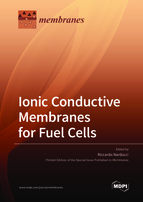Ionic Conductive Membranes for Fuel Cells
A special issue of Membranes (ISSN 2077-0375). This special issue belongs to the section "Membrane Applications".
Deadline for manuscript submissions: closed (31 July 2020) | Viewed by 55524
Special Issue Editor
2. International Laboratory Ionomer Materials for Energy (LIME), 00133 Roma, Italy
Interests: synthesis and characterization of anionic and ampholytic membranes for fuel cells (FCs); synthesis of inorganic materials (LDH, MOF); development of INCA method for ionomers
Special Issues, Collections and Topics in MDPI journals
Special Issue Information
Dear Colleagues,
The need to reduce pollution and the continuous increase in petrol cost have reinforced the interest in fuel cells (FCs), efficient and clean systems for the conversion of fuel into energy. Polymer electrolyte membrane fuel cells (PEMFCs) exhibit excellent characteristics in their weight, volume, and current density for automotive applications and co-generation systems. Unfortunately, the high cost of perfluorinated membranes and the low stability of anionic membranes in alkaline environment still limit their use.
This Special Issue on “Ionic Conductive Membranes for Fuel Cells” of the journal Membranes seeks contributions to assess state-of-the-art and future developments in the field of ionomeric membranes for fuel cells. Topics include, but are not limited to, new ionomer developments, composite membranes, manufacturing techniques, characterization, FC applications, demonstration efforts, and industrial exploitation. Authors are invited to submit their latest results; both original papers and reviews are welcome.
Dr. Riccardo Narducci
Guest Editor
Manuscript Submission Information
Manuscripts should be submitted online at www.mdpi.com by registering and logging in to this website. Once you are registered, click here to go to the submission form. Manuscripts can be submitted until the deadline. All submissions that pass pre-check are peer-reviewed. Accepted papers will be published continuously in the journal (as soon as accepted) and will be listed together on the special issue website. Research articles, review articles as well as short communications are invited. For planned papers, a title and short abstract (about 100 words) can be sent to the Editorial Office for announcement on this website.
Submitted manuscripts should not have been published previously, nor be under consideration for publication elsewhere (except conference proceedings papers). All manuscripts are thoroughly refereed through a single-blind peer-review process. A guide for authors and other relevant information for submission of manuscripts is available on the Instructions for Authors page. Membranes is an international peer-reviewed open access monthly journal published by MDPI.
Please visit the Instructions for Authors page before submitting a manuscript. The Article Processing Charge (APC) for publication in this open access journal is 2700 CHF (Swiss Francs). Submitted papers should be well formatted and use good English. Authors may use MDPI's English editing service prior to publication or during author revisions.
Keywords
- membrane
- protonic ionomers
- anionic ionomers
- composite membranes
- PEMFCs
- conductivity
- stability







